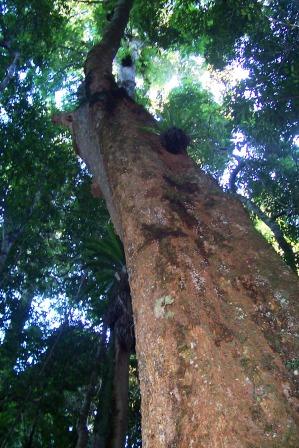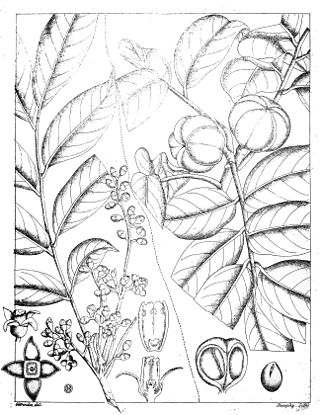
Meliaceae, the mahogany family, is a flowering plant family of mostly trees and shrubs in the order Sapindales.

Pehr Osbeck was a Swedish explorer, naturalist and an apostle of Carl Linnaeus. He was born in the parish of Hålanda on Västergötland and studied at Uppsala with Carolus Linnaeus.

Cauliflory is a botanical term referring to plants that flower and fruit from their main stems or woody trunks, rather than from new growth and shoots. It is rare in temperate regions but common in tropical forests.

Dysoxylum is a genus of rainforest trees and shrubs in the flowering plant family Meliaceae. About 34 species are recognised in the genus, distributed from India and southern China, through southeast Asia to New Guinea, Solomon Islands, and Australia. The name Dysoxylum derives from the Greek word ‘Dys’ meaning "bad" referring to "ill-smelling" and ‘Xylon’ meaning "wood".

Melia is a genus of flowering trees in the family Meliaceae. The name is derived from μελία, the Greek name used by Theophrastus for Fraxinus ornus, which has similar leaves.

Didymocheton fraserianus, commonly known as rosewood or rose mahogany, is a medium-sized to large tree native to New South Wales and Queensland. It is widely used with the purpose of street design and to provide shade in the eastern suburbs of Sydney. Rosewood ranges from the rainforest around eastern Australia from Bundaberg in Queensland to Wyong in New South Wales. At maturity, it can reach a height of 57 metres (200 ft). It is generally known for its strong scent of rose from its bark.

Didymocheton muelleri, the red bean or Miva mahogany, is a rainforest tree in the family Meliaceae. It occurs in tropical, sub-tropical and littoral rainforests in eastern Australia, from the Bellinger River in New South Wales in the south, to the wet tropics of north-eastern Queensland. A signposted red bean tree may be seen near the car park of Victoria Park Nature Reserve in north-eastern New South Wales.

Didymocheton pettigrewianus, commonly known as spur mahogany, spurwood, or Cairns satinwood, is a large tree in the family Meliaceae. It is native to the rainforests of Malesia, Papuasia and Queensland. In Queensland it occurs only in a small part of the northeast coast.

Gymnostoma australianum, commonly known as the Daintree pine or Daintree oak, is a species of small tree which is endemic to a restricted area of the Daintree tropical rainforests region, within the Wet Tropics of north-eastern Queensland, Australia. It is a member of the plant family Casuarinaceae, often named she-oaks, members of which are characterised by drooping equisetoid evergreen foliage, and separate male and female flowers (unisexual). Superficially they look like well known scale–leaved gymnosperm trees species, such as Cupressus in the northern hemisphere and Callitris in the southern hemisphere.
Prasoxylon alliaceum is a tree in the family Meliaceae. The specific epithet alliaceum is from the Latin meaning 'onion-like', referring to the smell of the inner bark.
Dysoxylum carolinae is a tree in the family Meliaceae. It is named for the English botanist Caroline Pannell.
Epicharis cuneata is a tree in the family Meliaceae.

Dysoxylum macrocarpum is a tree in the family Meliaceae. The specific epithet macrocarpum is from the Greek meaning 'large fruit'.
Dysoxylum rugulosum is a tree in the family Meliaceae. The specific epithet rugulosum is from the Latin meaning 'small wrinkles', referring to the surface of the leaflets.

Goniocheton arborescens, commonly known in Australia as Mossman mahogany, is a small tree in the mahogany family Meliaceae. It is native to rainforests of Malesia, Papuasia, Queensland and nearby islands.
Epicharis densiflora is a tree in the family Meliaceae. The specific epithet densiflora is from the Latin meaning 'dense flowers'.

Lansium is a genus of plants in the family Meliaceae, containing at least three species. The species Lansium domesticum is a tropical fruit-bearing tree that is cultivated in tropical Southeast Asia, and on a much smaller scale elsewhere in the tropics. Other previously named species are now placed in the genera Aglaia, Epicharis and Reinwardtiodendron.

Didymocheton gaudichaudianus, commonly known as ivory mahogany, is a species of rainforest tree in the family Meliaceae, native to Malesia, Papuasia, Queensland, and some southwest Pacific islands.

Epicharis is a genus of flowering plants in the family Meliaceae. It includes seven species which range from Indochina to south-central China, Taiwan, Malesia, Papuasia, Queensland, and Fiji.
Dysoxylum acutangulum is a species of flowering plant in the mahogany family, Meliaceae. It is a tree native to Peninsular Thailand, Malesia, New Guinea and the Solomon Islands, and the Northern Territory and Queensland in Australia.






















